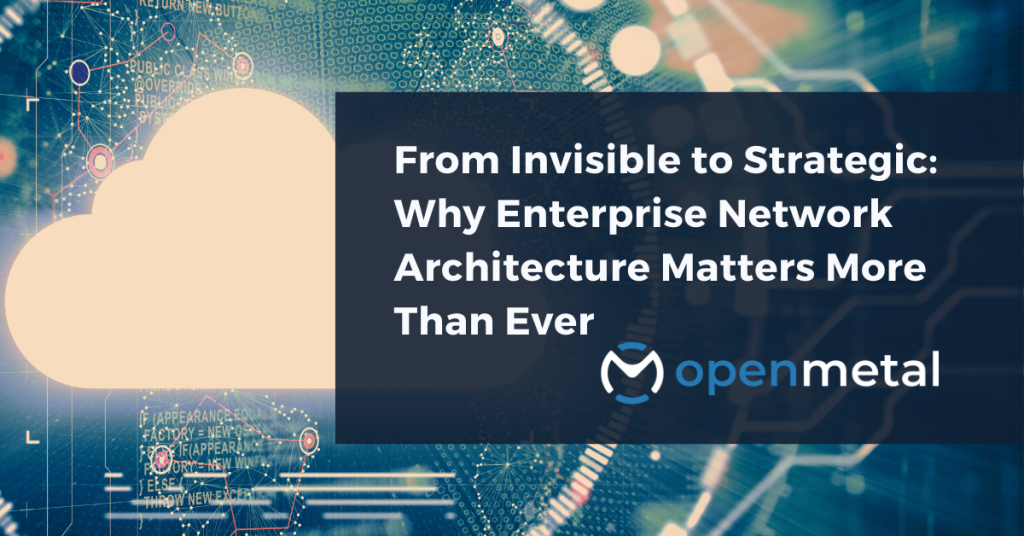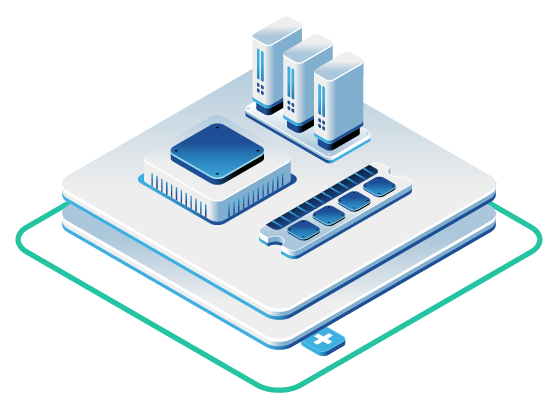
Want to leverage OpenMetal’s Network Architecture?
The OpenMetal team is standing by to assist you with scoping out a fixed-cost model based infrastructure plan to fit your needs, budgets and timelines.
While hyperscale public clouds have trained enterprises to view networking as “invisible infrastructure,” the reality is far different. Network architecture is becoming more strategic than ever, driving performance, costs, and competitive advantage. Organizations moving to hosted private cloud platforms like OpenMetal are rediscovering network transparency, predictable economics, and the control needed for AI workloads, SaaS platforms, and hybrid cloud strategies.
The Invisible Network Myth
The public cloud era promised to make infrastructure concerns disappear behind simple APIs and pay-as-you-go pricing models. For many IT teams, networking became an afterthought—something that “just worked” in the background while they focused on applications and services. This abstraction was intentional: hyperscale providers wanted to simplify the developer experience and reduce operational overhead.
However, this invisibility comes with significant trade-offs. What appears seamless on the surface often conceals complex billing structures, performance limitations, and architectural constraints that can impact your business in unexpected ways. AWS’s monthly data transfer costs for outbound data to the public internet are $0.09 per GB for the first 10 TB, dropping to $0.085 per GB for the next 40 GB, $0.07 per GB for the next 100 TB, and $.05/GB greater than 150 TB, creating unpredictable cost escalation as your business scales.
Why Network Architecture Is Regaining Strategic Importance
Several converging trends are making network design critical to business success:
Data Gravity and AI Workloads Drive Bandwidth Demands
AI and machine learning workloads generate massive east-west traffic patterns between GPU clusters, storage systems, and compute resources. These applications require high-throughput, low-latency networking that’s often constrained by hyperscale cloud architectures. Traditional cloud networking wasn’t designed for the bandwidth-intensive coordination required by distributed AI training or inference workloads.
SaaS Platforms Need Multi-Tenant Isolation
Software-as-a-Service companies must balance performance with strict tenant isolation for regulatory compliance. This requires sophisticated network segmentation capabilities that go beyond basic virtual networking. Customer-specific VLANs and traffic isolation become essential for maintaining security boundaries while delivering consistent performance across multiple tenants.
Hybrid Cloud Strategies Demand Routing Flexibility
Enterprises pursuing multi-cloud or hybrid cloud architectures need granular control over how data flows between on-premises systems and cloud resources. This includes the ability to bring your own IP addresses, implement custom routing policies, and avoid vendor lock-in through proprietary networking schemes.
Cost Transparency Becomes Competitive Advantage
As cloud bills scale with business growth, understanding exactly what drives networking costs becomes crucial for financial planning and optimization. AWS charges significantly more for data transfer than competitors, with outbound data costs starting at $0.09 per GB compared to DigitalOcean’s flat $0.01 per GB rate for all data transfer types, highlighting how networking can become a major expense category.
The Hidden Costs of Hyperscale Cloud Networking
Public cloud providers have built networking models that optimize for their operational efficiency and revenue generation, not necessarily customer predictability or cost efficiency.
Opaque Egress Billing Creates Lock-In
AWS’s complex and high egress pricing often results in customer lock-in, as it both increases the amount they can charge for services, and causes lock-in when customers look to leave AWS. When every gigabyte leaving the cloud incurs charges, architectural decisions become constrained by billing considerations rather than technical requirements.
The tiered pricing structure adds complexity: For EC2 egress costs, the first ten terabytes (TB) of data transferred to the internet monthly are charged at $0.09 per GB. Beyond this, transfers up to 40 TB per month are billed at $0.085 per GB. While larger organizations may benefit from volume discounts, this model makes cost forecasting challenging and can create unexpected budget impacts during traffic spikes.
Multi-Tenancy Limits Performance Consistency
Hyperscale clouds share network infrastructure across thousands of customers, making performance highly variable. You’re competing for bandwidth with other tenants, and during peak usage periods, your applications may experience degraded throughput or increased latency. This variability makes it difficult to provide consistent user experiences or meet strict SLAs.
Limited Architectural Transparency
Public clouds abstract away the underlying network topology, making it difficult to optimize for your specific workload patterns. You can’t see network utilization, understand traffic flows, or implement custom routing policies. This black-box approach works for simple workloads but becomes a limitation for sophisticated applications requiring network-level optimization.
OpenMetal’s Transparent Network Architecture
OpenMetal’s hosted private cloud takes a fundamentally different approach to networking, prioritizing visibility, control, and economic predictability.
Generous Bandwidth with Fair Billing
Each OpenMetal server includes substantial outbound public bandwidth, with overages billed using the 95th percentile model. The 95th percentile is a method of metering bandwidth usage that allows clients to slightly burst over their committed rate, giving the carrier an ability to scale their billing with the cost of the infrastructure and transit commits.
This approach, common in traditional data centers but rare in public clouds, ensures you’re not penalized for short-term traffic spikes. The 95th percentile method samples data transferred over the network every 5 minutes and, when finished, discards the top 5% of the traffic. This way, unusual traffic peaks are removed from the final bill. You only pay for sustained bandwidth usage, not temporary bursts.
High-Performance Private Networking
Every OpenMetal server comes equipped with dual 10 Gbps NICs providing 20 Gbps aggregate bandwidth for private networking. This dedicated capacity enables high-throughput workloads without the performance variability of shared infrastructure. All private network traffic is unmetered, allowing you to freely replicate data, coordinate cluster operations, and synchronize databases without cost concerns.
Customer-specific VLANs provide traffic isolation for compliance requirements, while VXLAN-ready VLANs support modern overlay networking and software-defined infrastructure. This flexibility enables sophisticated network architectures that would be impossible or expensive to implement in hyperscale clouds.
Bring Your Own IP and DDoS Protection
OpenMetal supports bringing your own IP ranges or can provide dedicated IP blocks, giving you routing flexibility that reduces vendor lock-in. This is particularly valuable for organizations with existing network infrastructures or specific regulatory requirements.
Built-in DDoS protection up to 10 Gbps per IP provides security without additional cost, while IPMI remote management ensures you maintain hardware-level access even during network disruptions. Network SLAs back these capabilities with uptime commitments you can rely on for production workloads.
Real-World Impact: Workload Examples
AI/ML Training and Inference
Machine learning workloads generate enormous amounts of east-west traffic as data moves between GPUs, storage systems, and parameter servers. A typical distributed training job might move terabytes of data between nodes during gradient synchronization.
In hyperscale clouds, this traffic is often subject to inter-availability zone charges and performance limitations. OpenMetal’s unmetered private networking and 20 Gbps aggregate bandwidth per server eliminates these constraints, allowing AI teams to focus on model development rather than optimizing for network billing.
SaaS Platform Architecture
Multi-tenant SaaS platforms require sophisticated network segmentation to maintain security boundaries while delivering consistent performance. Customer data must be isolated at the network level, often requiring dedicated VLANs or overlay networks.
OpenMetal’s customer-specific VLAN support and VXLAN capabilities enable SaaS companies to implement proper tenant isolation without the complexity and cost of hyperscale cloud virtual networking. The predictable bandwidth pricing also makes it easier to maintain consistent margins across customers.
Media and Content Delivery
Video streaming, software distribution, and other content-heavy applications generate massive egress traffic. Traditional per-gigabyte billing can make these workloads prohibitively expensive in public clouds, especially during viral content events or product launches.
The 95th percentile billing model is particularly valuable for media companies, as it accommodates traffic spikes without penalizing sustained high-bandwidth usage. Most customers’ bandwidth usage is minimal both during weekends and off-business hours during the week. However, it follows a curve during business hours and it even doubles during brief periods of time throughout the day.
Hybrid Cloud Integration
Organizations pursuing hybrid cloud strategies need flexible routing and the ability to integrate cloud resources with existing data center infrastructure. This often requires custom IP addressing, specific routing policies, and predictable network performance.
OpenMetal’s support for bringing your own IP ranges and the transparent network architecture makes hybrid integration significantly simpler than working within the constraints of hyperscale cloud networking models.
The Economics of Network Transparency
The financial benefits of transparent networking extend beyond simple per-gigabyte cost comparisons. When you can see and control your network architecture, you can optimize for your specific business requirements rather than working around provider limitations.
Predictable Cost Scaling
Bandwidth chart example shows that the 95th percentile method allows customers to exceed their commit rate for brief periods of time without a financial penalty nor the need of purchasing more bandwidth. This predictability makes financial planning more accurate and removes the fear of unexpected bandwidth charges during business growth or seasonal traffic patterns.
Reduced Vendor Lock-In
When you control your IP addressing and can implement custom routing policies, migrating between providers or implementing multi-cloud strategies becomes feasible. The ability to bring your own IP ranges means you’re not dependent on provider-specific network configurations.
Optimization for Business Requirements
With transparent network architecture, you can optimize for your specific performance, compliance, and cost requirements. This might mean implementing dedicated network paths for high-priority traffic, custom security policies for regulated data, or cost-optimized routing for bulk transfers.
Making Network Architecture a Strategic Asset
The most successful organizations treat network architecture as a strategic enabler rather than a necessary cost. This requires moving beyond the “invisible infrastructure” model and actively designing networks that support business objectives.
Align Network Design with Business Requirements
Different workloads have different networking needs. AI training requires massive east-west bandwidth, SaaS platforms need multi-tenant isolation, and media delivery demands cost-effective egress. Design your network architecture to optimize for your specific requirements rather than accepting generic cloud defaults.
Prioritize Visibility and Control
Choose infrastructure that provides visibility into network utilization, costs, and performance. The ability to see what’s happening in your network is essential for optimization and troubleshooting. Control over routing, addressing, and traffic policies enables you to implement business-specific requirements.
Plan for Predictable Economics
Network costs should scale predictably with your business growth. Billing models that penalize traffic spikes or create unexpected charges make financial planning difficult and can constrain business operations. Look for transparent pricing that aligns with your usage patterns.
Conclusion: Network Architecture as Competitive Advantage
The cloud era promised to make infrastructure invisible, but the reality is that network architecture has become more important than ever. Organizations that understand and actively manage their network design gain significant advantages in performance, cost predictability, and operational flexibility.
Hyperscale public clouds optimized their networking models for their business requirements, not necessarily yours. As workloads become more sophisticated and data-intensive, the limitations of these generic approaches become increasingly apparent.
OpenMetal’s hosted private cloud demonstrates how transparent network architecture can deliver both technical and economic benefits. By providing visibility, control, and predictable economics, it enables organizations to optimize their infrastructure for specific business requirements rather than working around provider constraints.
The question isn’t whether network architecture matters—it’s whether you’re treating it as a strategic asset or accepting it as a hidden constraint. In an increasingly data-driven economy, that choice will significantly impact your competitive position.
Take Action: Ready to rediscover what transparent network architecture can do for your organization? Explore how OpenMetal’s hosted private cloud can provide the visibility, control, and predictable economics your business needs to thrive in the data-intensive future.
OpenMetal Can Help With a PoC Cloud
Start with a risk-free evaluation: Take advantage of OpenMetal’s Proof of Concept program to validate how hosted private cloud can transform your delivery model.
Works Cited
- DigitalOcean. “Understanding AWS’s Egress Costs.” DigitalOcean Resources, https://www.digitalocean.com/resources/articles/aws-egress-costs. Accessed 25 Aug. 2025.
- Nops. “AWS Egress Costs in 2025: How to Reduce Them?” Nops Blog, 2 June 2025, https://www.nops.io/blog/aws-egress-costs-and-how-to-avoid/. Accessed 25 Aug. 2025.
- Noction. “95th percentile and other bandwidth metering methods.” Noction Blog, 11 Jan. 2023, https://www.noction.com/blog/95th-percentile-explained. Accessed 25 Aug. 2025.
- Stackscale. “What’s the 95th percentile billing method?” Stackscale Blog, 3 Nov. 2023, https://www.stackscale.com/blog/95-percentile-metering-billing-bandwidth/. Accessed 25 Aug. 2025.
- Tata Communications. “AWS’ Egress Costs: A Complete Guide.” Tata Communications Knowledge Base, 3 July 2025, https://www.tatacommunications.com/knowledge-base/aws-egress-cost/. Accessed 25 Aug. 2025.


































